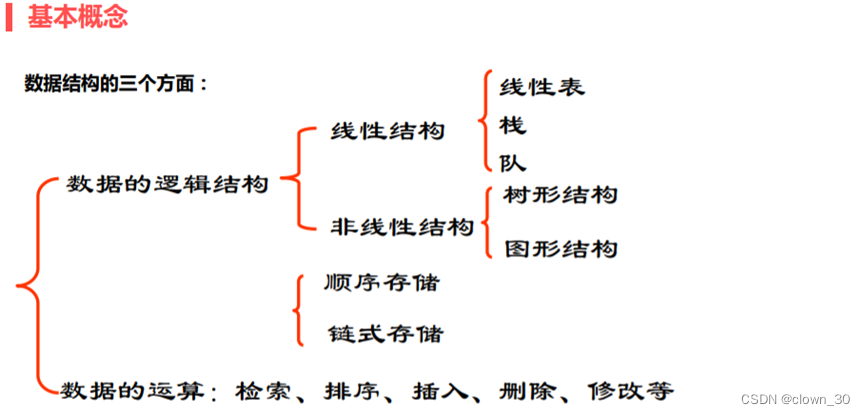
1.线性表
![]()
线性表特征:

- 对非空表,a0是表头,无前驱
- a(n-1)是表尾,无后继
- 其他的都有ai前驱a(i-1)与后继a(i+1)。
2、顺序结构存储方式是线性表存储的一种方式,主要体现形式为数组。

#include<stdio.h>
#include<stdlib.h>
#include<string.h>
#define SIZE 10
typedef int data_t;
typedef struct list{
data_t data[SIZE];//保存数据的数组(表)
data_t last;//保存尾元素的下标
} seqlist,*seqlist_t;
//创建顺序表
seqlist* create_selist()
{
seqlist_t head =(seqlist*) malloc (sizeof(seqlist));
if(NULL==head) return NULL;
memset(head->data,0,sizeof(head->data));
head->last=-1;//表示空
return head;//返回表头
}
//判空:
int seqlist_is_empty(seqlist* head)
{
if(NULL==head) return -1;
return (-1==head->last)?1:0;
}
//判满
int seqlist_is_full(seqlist * head)
{
if(NULL==head) return -1;
return (SIZE==head->last+1)?1:0;
}
//求元素个数
int seqlist_is_num(seqlist * head)
{
if(NULL==head) return -1;
return (head->last+1);
}
//指定位置增加元素
int seqlist_is_install(seqlist * head,int pos,data_t val)
{
if(NULL==head) return -1;//指向为空
if(1==seqlist_is_full(head)) return -2; //线性表已经满了
#if 1
int i=seqlist_is_num(head);//1、数量初始化i
for ( i ; i>pos; i--)//此处i可以等于也可以不等于pos
{
head->data[i]=head->data[i-1];
}
#else
int i=head->last;//2、下标初始化i
for ( i ; i>=pos; i--)
{
head->data[i+1]=head->data[i];
}
#endif
head->data[pos]=val;
head->last++;
return 0;
}
//指定位置删除元素
int seqlist_is_del(seqlist * head,int pos)
{
if(NULL==head) return -1;//指向为空
if(1==seqlist_is_empty(head)) return -2; //线性表为空
for (int i=pos;i<head->last; i++)
{
head->data[i]=head->data[i+1];
}
head->last--;
return 0;
}
//修改指定位置元素
int seqlist_is_change(seqlist * head,int pos,int val)
{
if(NULL==head) return -1;//指向为空
if(1==seqlist_is_empty(head)) return -2; //线性表为空
head->data[pos]=val;
return 0;
}
//查找元素
int seqlist_is_find(seqlist * head,int val)
{
if(NULL==head) return -1;//指向为空
if(1==seqlist_is_empty(head)) return -2; //线性表为空
for (int i = 0; i<=head->last; i++)
{
if(head->data[i]==val)
{
return i;
}
}
return -1;
}
//输出数组
int seqlist_is_print(seqlist *head)
{
if(NULL==head) return -1;//线性表为空
for (int i = 0; i <seqlist_is_num(head); i++)
{
printf("%d ",head->data[i]);
}
puts("");
}
int main()
{
seqlist * phead=create_selist();
seqlist_is_install(phead,0,1);
seqlist_is_install(phead,1,2);
seqlist_is_install(phead,2,3);
seqlist_is_install(phead,3,4);
seqlist_is_install(phead,4,5);
seqlist_is_install(phead,5,6);
//seqlist_is_install(phead,2,1233);
seqlist_is_change(phead,3,11111);
int k=seqlist_is_find(phead,3);
if(k>-1)
{
printf("找到位置为%d\n",k);
}
else
{
printf("不存在要找的数\n");
}
// seqlist_is_del(phead,3);
seqlist_is_print(phead);
return 0;
}